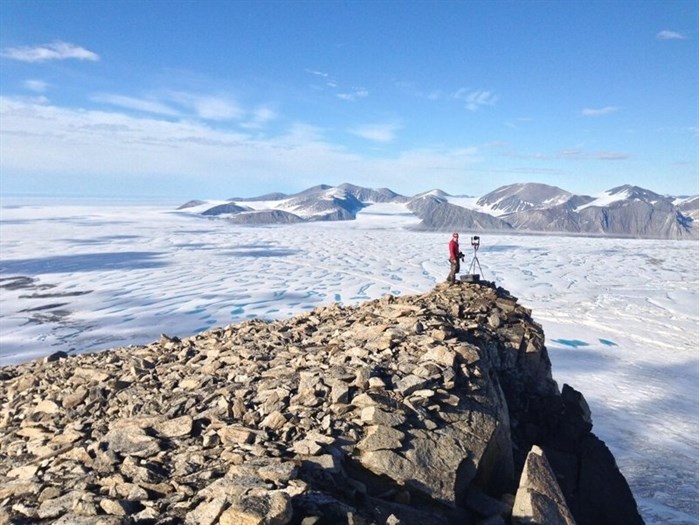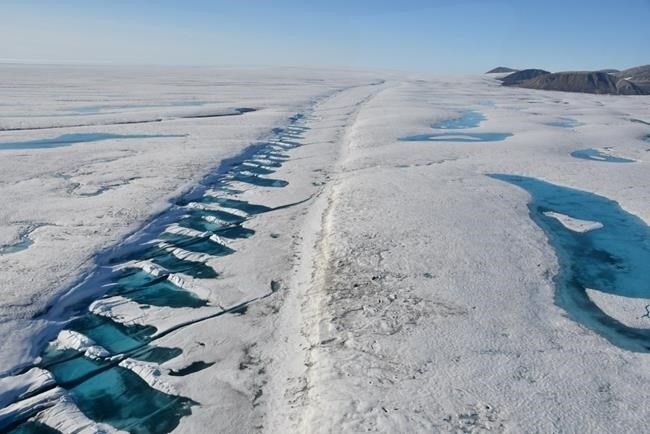
This July 2015 photo taken by University of Ottawa glaciology professor Luke Copland shows Canadian Ice Service ice analyst Adrienne White taking a photo of cracks of the Milne Ice Shelf, which just broke apart. The Milne ice shelf was on of the Arctic's few remaining intact ice shelves, but at the end of July 2020 about 43 per cent broke off. Scientists say that without a doubt it's man-made global warming.
Image Credit: (Luke Copland via AP)
August 08, 2020 - 5:29 AM
A team of scientists placed research instruments into the Milne Ice Shelf in Nunavut last July, with plans to return to collect them this summer and study how the stability of the structure had changed.
The COVID-19 pandemic put that trip on hold. Then a week ago, the last remaining intact ice shelf in the Canadian arctic broke apart.
"And so we've lost not only the equipment, which is now drifting away in the Arctic Ocean, but also the information that it recorded over the time that it was out," Carleton University glaciologist Derek Mueller said Friday.
The Canadian Ice Service said the ice shelf on the northwestern edge of Ellesmere Island has shrunk 43 per cent to 106 square kilometres from 187 square kilometres.
The calving event, captured by satellite, was not a surprise, Mueller said.

A rift in the Milne Ice Shelf on Ellesmere Island is shown in a 2019 handout photo. The Canadian Ice Service says a huge chunk has broken off Canada's last fully intact ice shelf on the northwest coast of Nunavut's Ellesmere Island. The Milne Ice Shelf is 40 per cent smaller after the split that began late last month.
Image Credit: THE CANADIAN PRESS/HO-Carleton University-Derek Mueller
The ice shelf sits in a fjord sheltered by tall cliffs, so it had not melted as quickly as others.
While it managed to stay together until last week, Mueller said he had observed worsening cracks and rifts since he first started studying the area in 2004.
"It certainly has been changing — there's no doubt. And, to me, it wasn't really a question of if this breakup would happen. It was a question of when it would happen," Mueller said.
"But still it hits home. It's sort of like losing a good friend in a way."
The ice shelf collapse also set adrift research into marine organisms, such as sponges and sea anemones, discovered in water pockets within the ice.
"We're not sure what these consequences are for these animals. And certainly they won't be where we were studying them, because that piece has drifted away from the shore," Mueller said.
"If we find these kinds of animals again, I think it will be a stroke of luck."
At the turn of the 20th century, 8,600 square kilometres of ice stretched along the northern coast of Ellesmere Island. By 2000, it was reduced to 1,000 and now it's half that, Mueller said.
University of Ottawa glaciologist Luke Copland said in a news release that the temperature has been up to 5 C warmer this summer than the average between 1981 and 2010.
The region has been warming at two to three times the global rate, he added.
"This drastic decline in ice shelves is clearly related to climate change," Copland said.
"The Milne and other ice shelves in Canada are simply not viable any longer and will disappear in the coming decades."
Mueller said the ice shelf collapse should be a wake-up call.
"These ice shelves are well out of balance with the climate and I think their demise is inevitable," he said.
"But, having said that, it's not too late to make changes to the way we live and our carbon footprint."
This report by The Canadian Press was first published on August 7, 2020
News from © The Canadian Press, 2020